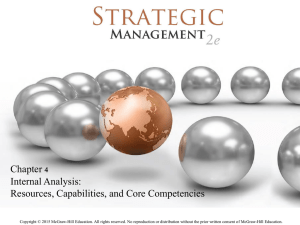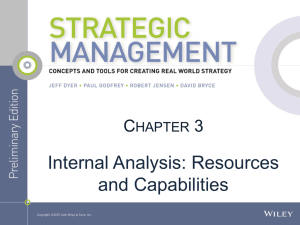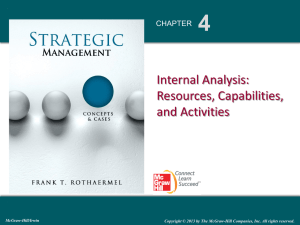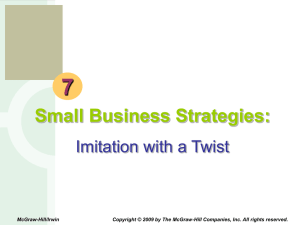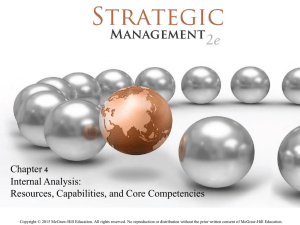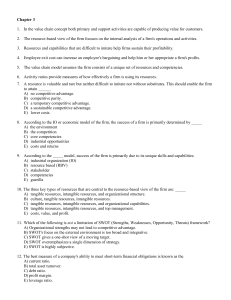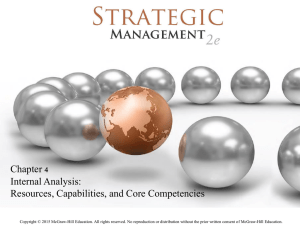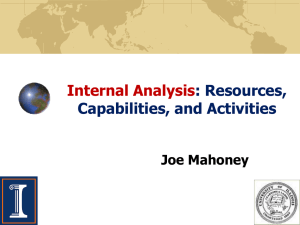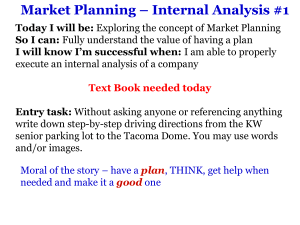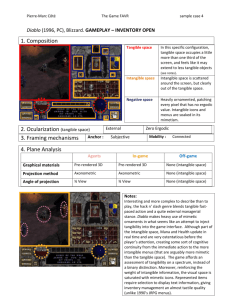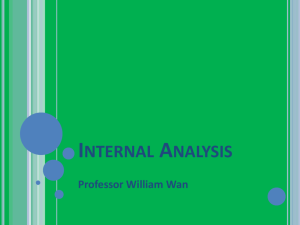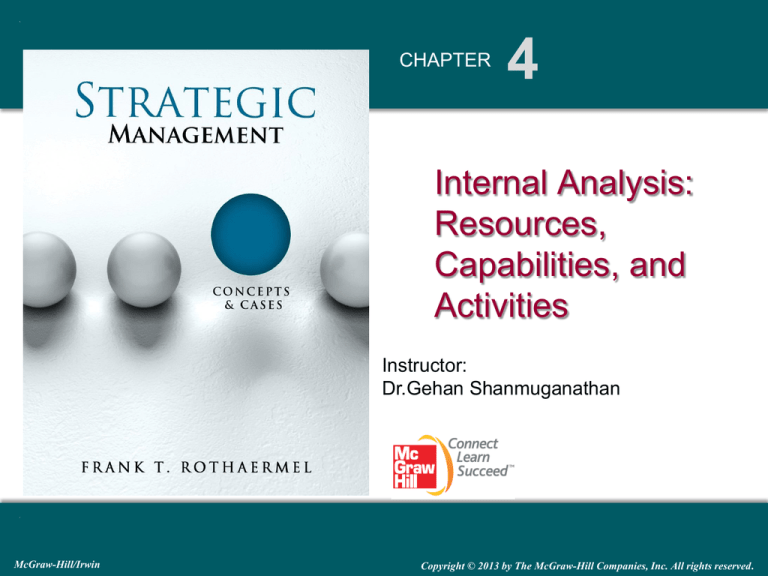
CHAPTER
4
Internal Analysis:
Resources,
Capabilities, and
Activities
Instructor:
Dr.Gehan Shanmuganathan
McGraw-Hill/Irwin
Copyright © 2013 by The McGraw-Hill Companies, Inc. All rights reserved.
LO 4-1 Distinguish among a firm’s resources, capabilities, core
competencies, and firm activities.
LO 4-2 Differentiate between tangible and intangible resources.
LO 4-3 Describe the critical assumptions behind the resource-based view.
LO 4-4 Apply the VRIO framework to assess the competitive implications
of a firm’s resources.
LO 4-5 Identify competitive advantage as residing in a network of firm
activities.
LO 4-6 Outline how dynamic capabilities can help a firm sustain
competitive advantage.
LO 4-7 Identify different conditions that allow firms to sustain their
competitive advantage.
LO 4-8 Conduct a SWOT analysis.
4-2
ChapterCase 4
From Good to Great to Gone:
• Circuit City
A GREAT performer from 1982 – 2000
World-class logistics & customer responsiveness
4S: service, selection, savings, & satisfaction
6 times better investment than GE under Jack Welch!
• Bankruptcy in fall of 2008!
Outflanked by firms like Best Buy and Amazon
4-3
INTERNAL ANALYSIS: Inside the Firm
• Comparing two firms in same industry:
Internal focus
Core Competencies
Unique strengths deep inside that differentiate a firm
Can drive competitive advantage
Strategic Fit
Internal strengths change with external environment
4-4
EXHIBIT 4.1
Creating Strategic Fit to Leverage Internal Strengths
4-5
Internal Analysis: Link to Superior Performance
• Combination of Resources & Capabilities
Builds core competencies
Competencies drive activities
To transform inputs into goods & services
Activities can produce competitive advantage &
performance
Reinvest profits from superior performance
Hone and upgrade core competencies
4-6
EXHIBIT 4.2 Linking Resources & Capabilities to Firm Performance
4-7
THE RESOURCE-BASED VIEW
• Tangible Resources
Visible, physical attributes
• Intangible Resources
No physical attributes
• Google Example
Tangible resources valued at $5 billion
Intangible brand valued at over $100 billion
Googleplex has BOTH tangible and intangible aspects
• Competitive Advantage More Likely…..
From INTANGIBLE resources
4-8
Two Critical Assumptions in RBV
• Resource heterogeneity
Bundles of resources and capabilities differ across firms
Southwest Airlines & Alaska Airlines have different
resources
SWA
– Higher employee productivity
– Informal organization, pilots help load luggage
• Resource immobility
Resources tend to be “sticky” & don’t move easily
Southwest Airlines sustained advantage
Several decades superior performance
Competitors have unsuccessfully imitated SWA model
4-9
EXHIBIT 4.5 Applying RBV: Decision Tree Competitive Implications
4-10
THE VALUE CHAIN
• Primary Activities
Add value directly in transforming inputs into outputs
Raw materials through production to customers
• Support Activities
Indirectly add value
Provide support to the primary activities
Information systems, human resources, accounting, etc.
• Managers can see how competitive advantage
flows from a system of activities
4-11
Dynamic Strategic Activity Systems
• A network of interconnected activities in the firm
• Evolve over time – external environment changes
Add new activities & upgrade or remove obsolete ones
• Vanguard Example
A global investment firm - $1.4 trillion managed assets
Emphasis on low customer cost and quality service
– Among the lowest expense ratios in the industry (0.20%)
Updated the activity system from 1997 to 2011
New customer segmentation core
Two new support activities
Permits customized offerings: long-term and more active
traders
4-12
EXHIBIT 4.8 Vanguard Group’s Activity System 2011
Legend
Core
Support
4-13
HOW TO PROTECT A COMPETITIVE ADVANTAGE
1. Better Expectations of Future Values
Buy Resources at a low cost
Real Estate Development - highway expansion
2. Path Dependence
Current alternatives are limited by past decisions
U.S. is the ONLY industrial nation not on the metric system
Honda’s core competency in gas engines took decades to
build
4-14
HOW TO PROTECT A COMPETITIVE ADVANTAGE
3. Causal Ambiguity
Cause of success or failure are not apparent
Why has Apple had such a string of successful products?
– Role of Steve Jobs’ vision?
– Unique talents of the Apple design team?
– Timing of product introductions?
4. Social Complexity
Two or more systems interact creating many possibilities
A group of 3 people has 3 relationships
A group of 5 people has 12 relationships
4-15
THE SWOT ANALYSIS
• Conduct a SWOT after external and internal
analysis completed
• SWOT combines external and internal analysis
Internal Strengths and Weaknesses
From VRIO framework
External Opportunities and Threats
From PESTEL or competitive forces analysis (Ch. 3)
Leverage internal strengths to exploit external
opportunities
Achieving such a dynamic fit yields sustained competitive
advantage
4-16

